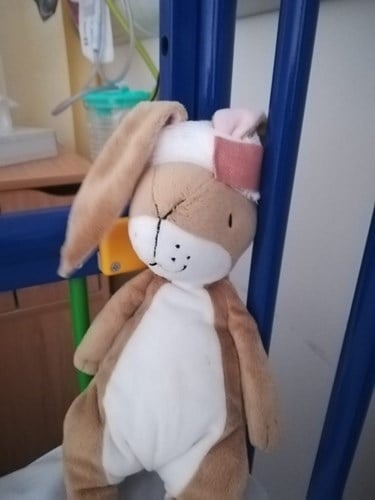Cochlear implant surgery day
Published Date: 20 Oct 2022
I wrote previously about the assessment process that we went through for Lucas’s cochlear implants. There’s something about a ‘process’ which is quite reassuring: you have a number of steps that you follow, and then you reach an end point – in our case that was surgery. Only it wasn’t an end point, it was the start of something very exciting, a turning point in our lives. Nonetheless, it was a scary day that had to be endured before its benefits could be enjoyed.
The date of Lucas’s surgery had been staring at us on the calendar from the start of the month, surrounded by asterisks and written in capital letters; the only day in June that mattered. Surgery day started early, and we loaded a sleepy baby and our bags into the car at 6.30am.
We arrived at the hospital and queued outside the ward with the other parents and their children who were nervously waiting for different surgeries that day, clutching bags and pillows. Lucas, at 11 months old, was the youngest child on the ward that day and so his surgery was scheduled first. This meant that no sooner had we found our bay, then an avalanche of efficient yet smiling healthcare workers descended on us. The nurses took his stats, the anaesthetist talked us through the sedation process, and the surgeon walked us through everything. As parents not famed for our love of early mornings, this required superhuman concentration, while simultaneously trying to put a wriggly and excited baby in a tiny hospital gown and stop him from pulling all the cables that were temptingly dangling from the wall.
Lucas went into surgery at 8.30am. I went into the room with him while he was sedated and held him as they placed a tiny mask over his face, and he locked eyes with me as he drifted to sleep in-between sobs. I was glad that I had been pre-warned by others who had been through this before – it’s a moment to prepare yourself for because it is upsetting. I feigned calm and strength for Lucas’s sake. The staff were amazing though and reassured me every step of the way. I gently laid my sleeping baby on the bed, kissed him and then I somehow walked out of the door, leaving the most important thing in my life with strangers. Hands down one of the hardest things I’ve had to do.
Next came ‘the wait’. I was handed a buzzer as I left the sedation room (the sort of thing they give you in the M&S cafe when you’ve ordered food) and was told to come back to collect Lucas when it buzzed in four to six hours’ time. Imagine the longest wait for food you’ve ever endured. Multiply that anticipation by one thousand. It still won’t come close. Never has a buzzer been stared at as much as our buzzer on that day.
The worst bit for me was going into the recovery room and seeing my usually smiling little boy with a huge bandage on his head, groggily coming round from the general anaesthetic. His teddy was on the bed next to him with a matching bandage on its head, propping up a little certificate of bravery. I’ll never forget those little human touches of kindness from the staff.
After a little while, I carried him back up to the ward, and then we cuddled him for the next 16 hours. He didn’t want to be put down, and he wasn’t able to sleep because of the nausea. There was vomit. Lots of vomit. My husband went home that night in scrubs borrowed from the hospital after being spectacularly vomited on. I stayed in the hospital with Lucas overnight until his sickness was under control, and while we were there the nurses took off Lucas’s huge bandage. Despite the size of the bandage, the wound and stitches were small and neat. In the morning we took him home.
Lucas recovered from his ordeal much quicker than we recovered from our lack of sleep and aching arms. He had a wobbly head, sticky out ears and a swollen face, but his smile was back in residence, and he even chose the day after surgery to pull himself up to standing for the first time and start cruising (great!). He needed less Calpol than he had after his four-week vaccinations, and within a few days he was back to himself, although his ears took a few weeks to go back to their normal size. These little people are truly amazing in their resilience.
It was a momentous, long, tiring, scary day without the benefit of knowing whether our decision to put Lucas through the surgery was the right one. No parent wants to put their child through any discomfort, and that makes implantation such a hard decision. I’m writing this four months later, safe in the knowledge that cochlear implantation has been life changing for us, but at the time all we could do was trust the process and trust the professionals. At the hospital we went to, that trust was rewarded, and we will always be grateful for the expertise, kindness and humanity that our family were shown that day – the day that marked the end of a long process but the start of the journey of a lifetime.
Ours isn’t the journey that everyone agrees with or chooses to take themselves, but this was the path that we followed, and it went as smoothly as we could have hoped.
